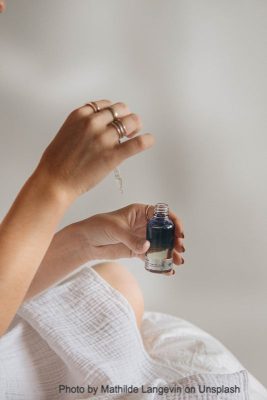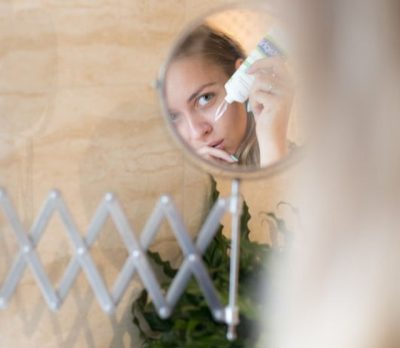Introduction to Basic Skincare Routine
Welcome to the world of skincare! Whether you’re a skincare newbie or looking to revamp your routine, we’ve got you covered. Achieving healthy, glowing skin is not just a dream; it’s a realistic goal when you follow a well-structured skincare routine. This guide will take you through skincare fundamentals, helping you understand your skin, its needs, and how to care for it effectively.
A healthy basic skincare routine consists of the following:
- Cleansing
- Exfoliation
- Toning
- Using Serums and Treatment Products
- Moisturizing
- Sunscreen (AM)
This article can be a step-by-step guide to help build a healthy skincare routine. You don’t have to start doing everything mentioned here; add something once a month or two. This would be healthy and less overwhelming.
1. Cleansing
Cleansing is the foundation of any skincare routine. It’s the first and vital step in achieving clean, healthy skin.

The importance of cleansing
Cleansing removes dirt, oil, makeup, and pollutants that accumulate on your skin throughout the day. Skipping this step can lead to clogged pores and breakouts.
Choosing the right cleanser
First, identify your skin type (oily, dry, combination, or sensitive). Then, select a cleanser designed for your specific needs. For example, a gentle, hydrating cleanser works well for dry skin, while a foaming cleanser is excellent for oily skin.
Frequency of cleansing
In most cases, washing your face with lukewarm (not hot) water in the morning and doing double cleansing in the evening is enough. I often see people using micellar water or harsh cleansing gels in the morning. If your skin is not very oily and greasy in the morning – use just water because otherwise, you might compromise your skin barrier, leading to dehydration, flakiness, and breakouts. (yes, even acne-prone skin deserves rest, and the skin barrier topic is much more sensitive for such skin!)
How to wash your face effectively
While using an oil cleanser (the first step of double cleansing), apply it with dry hands to dry skin, using it on the whole face and neck. Gently massage. You can make it sit for 30 seconds and then massage.
Massaging will help dissolve facial oils and, what is essential, your SPF, even if it’s water-resistant.
Some facial oils also clear pores, so paying more attention to the nose, forehead, and other “concerned” areas might help dissolve pores impurities, remove blackheads, and make pores appear smaller (because they are cleaner).
After that, wash it off with lukewarm water, and use your hands or a washing cloth.
While double cleansing (the second step), apply the cleanser to damp skin and gently massage in circular motions if using a non-foaming cleanser. Make foam in your hands, apply it to wet skin, and massage it for foaming. Rinse with lukewarm water. Pat your face dry with a clean towel, and avoid rubbing, as it might irritate the skin.
Need a cleanser for acne? See best face wash for acne. Or find the Best Cleanser for Oily Skin.
2. Exfoliation
Exfoliation is the key to achieving a smooth and radiant complexion.
What is exfoliation, and why it’s essential
Exfoliation involves removing dead skin cells from the surface of your skin. This process promotes cell turnover, leaving your skin looking fresh and vibrant.
Physical vs. chemical exfoliation
Physical exfoliation uses scrubbing particles to manually remove dead skin cells, while chemical exfoliation uses acids or enzymes to dissolve them. Nowadays, scrubbing is not very popular, as there’s plenty of information available, and now we know that it might damage the skin and worsen acne, dryness, etc. Chemical exfoliants (acids) and sometimes enzymes are recommended.
How often should you exfoliate
This varies from person to person, but generally, 1-2 times a week is a good starting point. Be mindful not to over-exfoliate, either by often exfoliation or harsh exfoliators. It can damage your skin and/or a skin barrier. So start slowly and use mild products.
Product recommendations
Depending on your skin type and needs, you can choose from various exfoliating products, such as glycolic acid toners, bha toners, acids in serums, or enzyme solutions.
Remember, consistency is vital to achieving that coveted healthy and glowing skin. If you have any questions or want personalized recommendations, please comment below. Your journey to beautiful skin has just begun!
3. Toning
Toning is an overlooked step that can significantly positively affect your skincare routine.
The purpose of toning in your routine
Toners help balance your skin’s pH, remove residual impurities, and prepare your skin to better absorb the subsequent skincare products.
Choosing the right toner for your skin type
Like cleansers, toners come in various formulations to suit different skin types. If you have oily skin, look for an oil-regulating toner. For dry or sensitive skin, opt for a hydrating, alcohol-free toner. If your skin is irritated, seek calming toners.
How to apply toner correctly
After cleansing, pour a small amount of toner onto a hand (you don’t need to use a cotton pad for that) and gently put the toner all over the face, press your hands onto the face gently tap. Don’t rub vigorously.
The benefits of toning
Aside from the cleansing and pH-balancing benefits, toners can provide added hydration, reduce redness, and refresh your skin.
Besides, applying other products like serums and moisturizers to the damp skin with the proper PH after toning will help them work better for your skin.
Read more about facial toners.
4. Face Serums and Treatment Products
Face serums are the superheroes of your skincare routine, targeting specific concerns effectively.

Why face serums are a skincare game-changer
Serums contain high concentrations of active ingredients designed to address fine lines, dark spots, or acne. They are usually thicker than toners (but not always), yet they are liquid and fast-absorbing. If combined correctly, you can layer several serums to achieve a better effect.
Targeting specific skin concerns with serums
Depending on your skin’s needs, you can choose face serums with ingredients like hyaluronic acid for hydration, vitamin C for brightening, niacinamide for brightening and pores control (read more in Niacinamide in Skincare), snail mucin for skin repairing, etc.
Using serums in your routine
Apply serums after toning but before moisturizing. A small amount goes a long way. Gently pat or massage the face serum onto your skin and allow it to absorb fully before moving on to the next step.
See more information about the art of layering skincare.
5. Moisturizing
Moisturizing is the final step to lock in hydration and keep your skin soft and supple.

The importance of moisturizing
Even if you have oily skin, moisturizing is crucial. It helps maintain your skin’s barrier, preventing moisture loss and protecting against environmental stressors (yes, the skin can be dehydrated and oily, and a damaged skin barrier can cause breakouts).
One of the best moisturizing and skin barrier-repairing ingredients is ceramides. Read about them in the ceramide moisturizer article.
Selecting the right moisturizer for your skin type
Like cleansers and toners, moisturizers come in various formulas. If you have dry skin, opt for a rich, hydrating cream. For oily skin, choose a lightweight, oil-free moisturizer or gel formula.
How to apply moisturizer for maximum benefits
After your serum(s) or toner(s) have absorbed but not dried completely, apply a small amount of moisturizer to your face and neck on the damp skin. Gently massage it in.
6. Sunscreen
Sunscreen is your best friend for protecting your skin from the sun’s harmful effects.
Sunscreen shields your skin from harmful UV rays, helping to prevent sunburn and premature aging and reducing the risk of skin cancer. Even expensive serums are useless if you don’t protect your skin from sun damage, as sun damage is one of the most potent contributors to skin aging. It then causes a decline in collagen and other things production (like Q10 and ceramides). So, if you’re not yet using sunscreen, this is your sign to start.
But be mindful that sunscreen doesn’t protect from 100% UV rays, so reapply sunscreen, wear a hat and sunglasses with UV protection, and seek the shadow when needed.
How to choose the right sunscreen
Look for a broad-spectrum sunscreen with at least SPF 50.
Applying sunscreen properly
Apply sunscreen as the last step in your morning routine (before makeup), about 15-20 minutes before going outside. Be generous with your application, and don’t forget often-overlooked areas like your neck and ears. Use sunscreen for every uncovered body part (hands and chest also get damaged!).
Sunscreen is a must, even on cloudy days, and might be skipped if you are not going anywhere and all the curtains are closed tight.
What sunscreen to use?
If your skin is oily and/or acne-prone, check the best sunscreen for oily skin article.
And read my Beauty of Joseon Sunscreen Review.
7. Nighttime Routine
A nighttime skincare routine is equally essential as your morning routine.
Why a nighttime routine is essential
Your skin repairs and regenerates while you sleep so that a dedicated nighttime routine can maximize these benefits.
The difference between AM and PM routines
AM routines focus on protection, while PM routines emphasize repair and rejuvenation.
Products to consider for nighttime use
In addition to the basics, you may include treatments like retinol, which can help with fine lines and wrinkles, or more effective exfoliation so that your skin has some time to repair before you go outside.
Read about a good retinol for beginners in the Beauty of Joseon Revive Eye Serum Review.
Why and How to use retinol?
8. Special Considerations
Combining active ingredients
Skincare active ingredients are supposed to improve skin conditions. However, not all active ingredients can be used together. Read more about What Skincare Ingredients Not to Mix and What to Mix.
Your skin is unique, and you may have specific concerns. Here are some tips for different situations
Skincare for sensitive skin
Sensitive skin can be prone to redness, irritation, and discomfort. Here are some tips for caring for sensitive skin:
- Gentle Products: Opt for skincare products specifically formulated for sensitive skin. Look for labels that mention “fragrance-free” and “hypoallergenic.” These products are less likely to contain ingredients that can trigger sensitivity.
- Patch Testing: Patch testing is an excellent idea before applying any new product to your face. Apply a small amount to a discreet area of your skin, like behind your ear, and wait 24-48 hours to see if it causes any adverse reactions.
- Avoid Harsh Ingredients: Steer clear of products with harsh ingredients, such as alcohol, strong acids, and fragrances. These can exacerbate sensitivity.
Skincare during pregnancy
Pregnancy can bring about changes in the skin, and some ingredients commonly found in skincare products may not be safe for expectant mothers. Here’s what to consider:
- Safe Ingredients: Look for products that are safe for use during pregnancy. Ingredients like hyaluronic acid, shea butter, and niacinamide are generally considered safe.
- Unsafe ingredients: Avoid retinoids during pregnancy and even while planning and breastfeeding.
- Product Recommendations: Consult with your healthcare provider for product recommendations tailored to your specific needs during pregnancy. They can guide suitable products for your skin type and concerns.
Skincare for mature skin
As we age, our skin changes, including a reduction in collagen and elasticity.
- Anti-aging Products: As we age, collagen production in our skin declines. Consider incorporating anti-aging products like serums or creams with ingredients such as retinol and peptides – skincare actives that boost collagen production in the skin. Read here how to increase collagen in face. These can help address fine lines, wrinkles, and loss of firmness. Better prevent, so using the same tips (and including SPF!) will help to postpone visual aging.
- Moisturization: Hydration is crucial for mature skin. A rich, hydrating moisturizer keeps the skin supple and prevents dryness.
- Sun Protection: Sunscreen is even more critical as you age. Protecting your skin from UV damage can help prevent further signs of aging.
Acne-prone skincare
Acne can be a challenging skin concern, but with the right products and habits, it can be managed effectively:
- Non-Comedogenic Products: Look for non-comedogenic products that won’t clog your pores. These are less likely to exacerbate acne.
- Salicylic Acid or Benzoyl Peroxide: Acne-fighting ingredients like salicylic acid and benzoyl peroxide can help control breakouts. (Be careful not to damage the skin and the barrier – use them as directed).
- Consult a Dermatologist: If your acne is severe or persistent, consider consulting a dermatologist. They can recommend prescription treatments and personalized advice for your skin.
9. Lifestyle and Diet
Your lifestyle and diet play a crucial role in the health and appearance of your skin. Let’s explore how these factors affect your skin and what you can do to maintain a vibrant complexion.

How your lifestyle and diet can affect your skin
- Stress, lack of sleep, and poor diet can damage your skin. Stress can lead to breakouts and exacerbate skin conditions. Sleep is essential for the body to repair and regenerate skin cells. A diet high in processed foods and sugar can contribute to inflammation and skin issues.
Tips for a skin-friendly diet
- Opt for a diet rich in fruits, vegetables, whole grains, and proteins. These foods provide essential vitamins, antioxidants, and nutrients that promote healthy skin. Omega-3 fatty acids in foods like salmon, avocado, and walnuts can help maintain your skin’s natural oil barrier.
The importance of hydration
- Proper hydration is vital to healthy skin. Drinking adequate water helps keep skin moist and supple, and hydrated skin is less prone to dryness and fine lines.
10. Additional Tips and Tricks
Importance of consistency in your routine
- Consistency is the key to seeing positive results in your skincare routine. Stick to your regimen, and don’t expect immediate changes. Over time, your skin will thank you for your dedication.
How to gradually introduce new products
- When adding new products to your routine, do so gradually. When it comes to exfoliation or retinol, start it slowly, once a week. For acids, use mild acids with a low concentration first. This allows your skin to adapt without overwhelming it. Start with one new product at a time, ideally one every few weeks.
Overcoming common skincare mistakes
- We all make mistakes in our skincare journey. Learn to correct them, whether over-exfoliating, using the wrong products, or neglecting sunscreen. I’m here to guide you on the path to healthier skin.
Conclusion about Basic Skincare Routine
Congratulations! You’ve completed the “crash course in skincare routine 101”.
Let’s recap the key takeaways:
- Start with the basics: cleansing, exfoliating, toning, and moisturizing.
- Protect your skin with sunscreen, even on cloudy days.
- Tailor your routine to your unique skin type and concerns.
- Consider the role of lifestyle, diet, and hydration in your skincare journey.
- Stay consistent, be patient, and gradually introduce new products.
The journey to healthy, glowing skin begins with the proper knowledge and commitment. Remember, skincare is a form of self-care, and taking care of your skin is an investment in your well-being.
Also, read winter skincare routine tips.
Want to buy something for your new or revised skincare routine with an extra discount?
Use the links and codes to get an extra discount:
- IHerb: https://www.iherb.com?rcode=NAT0553 or just a code NAT0553
- LookАantastic: https://www.lookfantastic.com/referrals.list?applyCode=NNMU-R4 or just a code on checkout NNMU-R4
- YesStyle – use this Rewards Code VZBZKB or follow the link https://www.yesstyle.com/en/home.html?rco=VZBZKB&utm_term=VZBZKB&utm_medium=Rewards&utm_source=dynamic&mcg=influencer
- StyleVana http://rwrd.io/lj8xhzt?c
Do you have questions or want to share your skincare experiences?
Join the conversation in the comments section below. I’d love to hear from you and assist with any queries you may have on your path to healthier, happier skin.
Related articles:
Looking for a retinol (retinal) product to start with? Read Beauty of Joseon Revive Eye Serum : Ginseng + Retinal Review.
If you’re considering trying a skincare product with scientifically proven benefits beyond retinol, consider checking out this article on peptide lip treatment.
Frequently Asked Questions
How often should I exfoliate my skin, and what exfoliator should I use?
Exfoliation is essential for maintaining healthy, glowing skin. Here are some guidelines:
Frequency
Generally, exfoliate 1 to 3 times a week, depending on your skin type and your chosen exfoliator.
Types of Exfoliators
- Chemical Exfoliants include alpha hydroxy acids (AHAs) like glycolic and lactic acids and beta hydroxy acids (BHAs) like salicylic acid. They gently dissolve dead skin cells and unclog pores. BHAs are oil-soluble and work better with pores, while AHAs work on the skin surface.
- Physical Exfoliants contain small granules or particles. Be cautious with physical scrubs, as they can be harsh. Opt for finely ground particles and use them gently. Avoid physical exfoliants if your skin barrier is compromised.
What are the benefits of using a serum, and how do I choose one that suits my skin type and concerns?
Serums are concentrated formulations packed with active ingredients. Here’s why they’re beneficial and how to choose the right one:
Serums Benefits
- Targeted Treatment: Serums address concerns like hydration, brightening, anti-aging, or acne.
- Lightweight: They penetrate deeply without feeling heavy.
- Potent Ingredients: Serums contain high concentrations of active compounds.
Choosing a Serum
- Skin Type: Consider your skin type (dry, oily, combination, sensitive). For dry skin, opt for hydrating serums; look for oil-free serums (see serum for oily skin).
- Concerns: Identify your skin concerns (e.g., fine lines, dark spots, dullness). Choose serums that target them, with ingredients like hyaluronic acid (hydration), vitamin C (brightening), or retinol (anti-aging).
Patch Test: Always patch-test new serums to ensure compatibility.
How do I know if I need to use an eye cream, and what ingredients should I look for?
Eye creams are designed for the delicate skin around the eyes. Here’s how to determine if you need one and what to look for:
Signs You Need an Eye Cream
- Dark Circles: If you struggle with dark circles or puffiness, an eye cream can help.
- Fine Lines and Wrinkles: Eye creams with peptides or retinol can target these signs of aging.
- Dryness: The skin around the eyes is thin and prone to dryness. You can slug instead of buying a separate eye cream targeting dryness, but this is a subject of personal taste.
Ingredients to Look For
- Hyaluronic Acid: Hydrates and plumps the skin.
- Vitamin C: Brightens and reduces dark circles.
- Glycolic acid and caffeine: Reduce puffiness.
- Peptides: Boost collagen production.
- Retinoids: Addresses fine lines.
Remember to apply eye cream gently using your ring finger and avoid pulling or tugging the delicate skin. 🌟